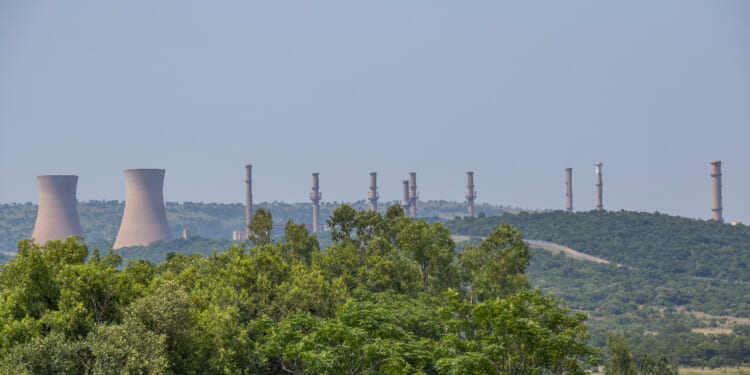US nuclear energy in Africa will help the economic growth of many African nations and curb Chinese and Russian influence in the region.
Nuclear energy will undoubtedly play a key role in Africa’s future, and China and Russia are beating the United States to the punch. Energy is not only a national security concern given the leverage it gives Beijing and Moscow, but it is also a massive business opportunity that touches all sectors of the economy, including critical minerals. Despite China and Russia’s advantage, the United States has an opportunity to reestablish itself as a serious competitor by focusing on the development of micro and small modular reactors (SMRs) and also working to coordinate better financing and private engagement to export this technology to its African partners.
600 million Africans lack access to electricity, which is nearly 40 percent of the continent. This shortage not only impacts health, with biomass pollution killing millions of African children every year and the lack of electricity limiting health services, but it also restricts economic development. Mines, data centers, and other economic projects driving economic growth on the continent are energy-intensive. The International Atomic Energy Agency (IAEA) estimates that economic growth in Africa will lead to electricity demand growing by 40 percent by 2030 and almost seven times its current level by 2050.
African countries are increasingly turning to nuclear energy, with half of the 30 IAEA “newcomer countries” located in Africa. Renewables, such as solar and wind, will surely feature in Africa’s future energy mix. However, larger energy base loads and more stable and economically efficient energy sources are needed to support the digitization, industrialization, and urbanization underpinning Africa’s economic growth.
While the will for nuclear energy clearly exists, African countries face various challenges in developing nuclear energy sources. First, large-scale power plants cost billions, mostly in upfront investments, which many governments cannot afford. Additionally, many countries lack the expertise to support the engineering, operational, and regulatory functions involved with nuclear energy. Lastly, nuclear energy requires extensive infrastructure—both “hard” infrastructure to support nuclear facilities and an expanded electric grid, as well as “soft” infrastructure, consisting of the necessary regulatory and institutional frameworks.
Russia has positioned itself as a global leader in the nuclear energy market, including in Africa. The Kremlin is an attractive partner thanks to its comprehensive aid package, which includes generous financing options, educational training, and infrastructure support, all easily accessible through the state-owned energy company Rosatom. 21 African countries have signed nuclear cooperation agreements with Russia in the last decade, including at least eight proposed or in-progress large-scale nuclear power plants. The Kremlin is also pursuing uranium mining deals in Africa to increase its grip on the nuclear energy market, with the continent holding 20 percent of global uranium reserves.
China is increasingly exporting its expertise. Beijing has rapidly expanded state-backed “nuclear” or “green” Belt and Road initiatives abroad, including in Africa, despite not offering any public nuclear energy financing in Africa from 2012 to 2021. Of the six African countries that have reached at least phase two of the IAEA nuclear development milestones, China has deals with four—Ghana, Kenya, Nigeria, and South Africa. In 2024, China held its first China-Africa Forum on the Peaceful Use of Nuclear Technology in Ethiopia, and it would hold future fora as part of its 2025-2027 Beijing Action Plan.
Chinese and Russian dominance in the nuclear sector will translate to long-term partnerships and leverage. Beijing and Moscow are securing decades of influence due to the long timelines and wide-ranging scope of nuclear energy projects. Energy also equates to leverage. African countries relying on Chinese- or Russian-backed energy projects or fuel may feel compelled—or be coerced—to align with China and Russia on sensitive topics to protect their economies and overall national security. Moscow has weaponized energy reliance against the West since it invaded Ukraine.
The United States is also missing out on substantial business opportunities by failing to prioritize the energy sector. Africa’s energy sector is one of the fastest-growing sectors on the continent. US companies were involved in over $25 billion worth of deals and had another $20 billion in upcoming projects at the beginning of 2025.
Critical mineral supply chains are also intertwined with energy infrastructure. US energy investments can help establish the energy infrastructure needed to support mineral production and entice greater mine development, securing US mineral access in the process.
The advent of micro and small modular reactors presents an opportunity for the United States to get back into the game. SMRs are better suited for many African countries due to their cheaper up-front cost and better compatibility with smaller energy grids. Their modularity also makes them more resilient to supply chain disruptions and better able to be safely deployed in a wider array of locations, such as rural areas and energy-intensive economic sites.
Fortunately for the United States, SMRs are better suited to American strengths than larger power plants. SMRs are much more compatible with private investment and innovation due to their lower cost, modularity, and potential for mass production. Large-scale power plants, on the other hand, suit China’s and Russia’s state-owned nuclear energy enterprises and the vast sums of public funding they bring to bear.
The United States already has many of the resources it needs to ride the wave of the SMR revolution. The United States has invested billions into developing SMRs over the last decade, and the Trump administration re-approved $900 million in funding to support the domestic SMR development as part of President Trump’s initiative to “unleash” American energy and quadruple nuclear energy production.
The Trump administration has also supported efforts to export this technology through continued support for the FIRST program, a government initiative to leverage public-private partnerships to support partner countries with training and capacity building, regulatory support, and procurement for SMRs. FIRST supports American companies and has already helped the United States secure deals to develop SMR technology in Ghana, Kenya, Nigeria, and Rwanda.
Still, the United States will be in fierce competition with China and Russia. Russia has deployed its first floating SMR domestically and is negotiating deals to export the technology to coastal African countries. China and Russia have both developed their first land-based SMRs and signed deals with South Africa and Zimbabwe, respectively, to eventually export SMR technology.
Given this position, the United States must focus on scaling up its efforts. Financing will remain a key issue, and joint funding arrangements—both for Western developers and African buyers—should be a focal point. The United States should work with its allies to help co-develop and co-finance SMR exports to Africa. Such partners include Argentina, Canada, Japan, and South Korea, all of which are FIRST contributing members with already-existing projects in Africa.
The United States’ engagement with Africa’s regional economic and power blocs will be critical. Africa has eight regional economic blocs and five regional power pools, which support cross-border electricity trading. Engaging these blocs will generate joint funding for multi-country projects. For SMRs, this could take the form of bulk orders, which would make SMR exports more financially viable for private companies. Regional energy investments will also support other regional infrastructure, trade, and investment opportunities, including in the critical mineral sector.
Another financing option, public-private partnerships, is becoming increasingly viable. Development finance institutions such as the World Bank and the European Bank for Reconstruction and Development have become more willing to fund nuclear energy projects in recent years. This shift will hopefully be mirrored by African and other international funding institutions that have avoided nuclear energy funding.
To support these various initiatives, the United States and its African partners should make better use of comprehensive tools already at their disposal—the African Continental Free Trade Area (AfCFTA) and Power Africa. For African countries, AfCTFA will help mobilize capital to invest in regional public-private partnerships and make it easier for countries to export surplus energy, both of which encourage the scaling of energy projects. AfCTFA will also enable African countries, especially those in the FIRST program, to become leading partners with the United States in further spreading nuclear technology and expertise on the continent without trade restrictions. For US companies, AfCFTA has the potential to create a more unified market and regulatory system across national borders, further enabling bulk orders and making it easier to work with multiple countries.
The Trump administration should restore funding to Power Africa, a program clearly aligned with the president’s energy initiatives that was, unfortunately, collateral damage during the 2025 DOGE cuts. The program had incentivized more than $80 billion in commitments from other private and public funding streams since 2013, resulting in an added 14.3 gigawatts of electricity and a more than tenfold return on its funding. Renewing Power Africa would secure more joint funding, public-private partnerships, and support other de-risking tools—such as loans and loan guarantees—to drive US investment.
African countries have identified nuclear energy as a promising energy source, and the United States should listen to its African partners. African countries do not want to be beholden to Beijing or Moscow, but Washington must offer competitive alternatives. The United States is well-positioned to do so with the advent of SMRs, but it must make better use of its tools to scale its current efforts.
About the Author: Liam Karr
Liam Karr is the Africa team lead for the Critical Threats Project at the American Enterprise Institute. He covers US national security in sub-Saharan Africa. He graduated from the University of Notre Dame with a B.A. in Political Science, History, and Arabic and an International Security Studies Certificate. Follow him on X/Twitter: @liam_karr.
Image: Shutterstock/Richard van der Spuy

















